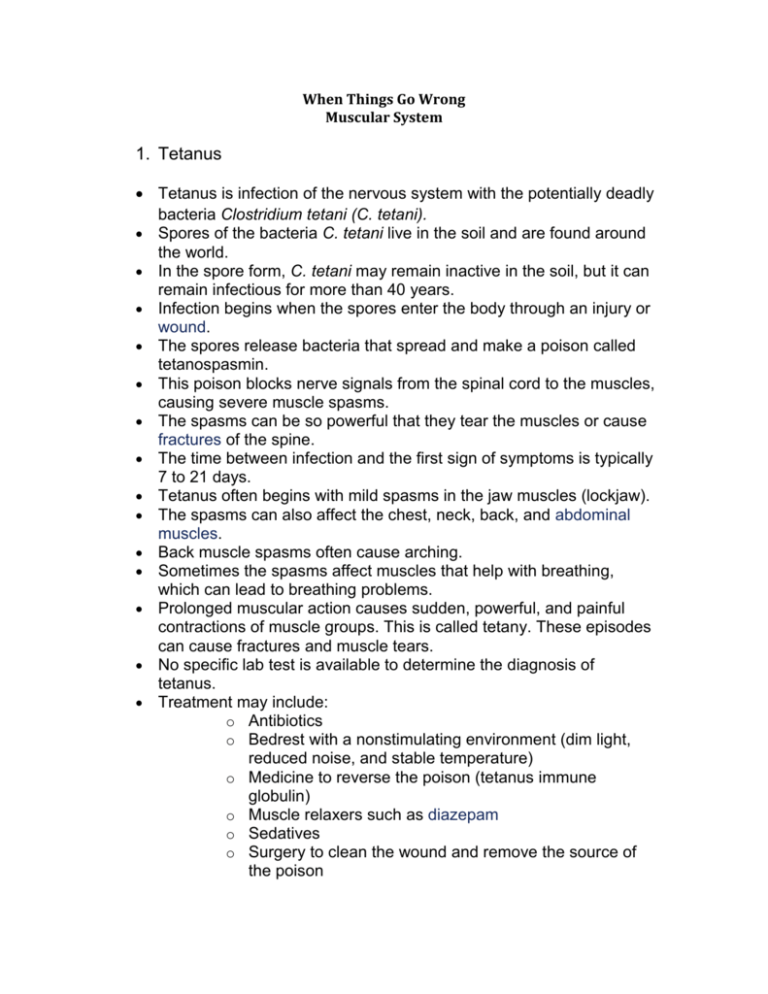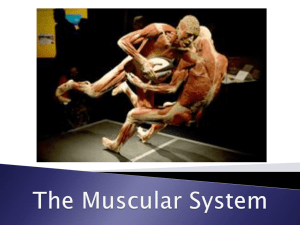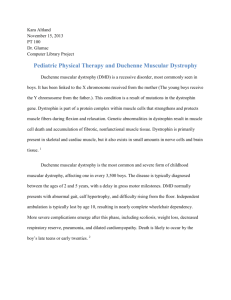WTGW, Muscles
advertisement

When Things Go Wrong Muscular System 1. Tetanus Tetanus is infection of the nervous system with the potentially deadly bacteria Clostridium tetani (C. tetani). Spores of the bacteria C. tetani live in the soil and are found around the world. In the spore form, C. tetani may remain inactive in the soil, but it can remain infectious for more than 40 years. Infection begins when the spores enter the body through an injury or wound. The spores release bacteria that spread and make a poison called tetanospasmin. This poison blocks nerve signals from the spinal cord to the muscles, causing severe muscle spasms. The spasms can be so powerful that they tear the muscles or cause fractures of the spine. The time between infection and the first sign of symptoms is typically 7 to 21 days. Tetanus often begins with mild spasms in the jaw muscles (lockjaw). The spasms can also affect the chest, neck, back, and abdominal muscles. Back muscle spasms often cause arching. Sometimes the spasms affect muscles that help with breathing, which can lead to breathing problems. Prolonged muscular action causes sudden, powerful, and painful contractions of muscle groups. This is called tetany. These episodes can cause fractures and muscle tears. No specific lab test is available to determine the diagnosis of tetanus. Treatment may include: o Antibiotics o Bedrest with a nonstimulating environment (dim light, reduced noise, and stable temperature) o Medicine to reverse the poison (tetanus immune globulin) o Muscle relaxers such as diazepam o Sedatives o Surgery to clean the wound and remove the source of the poison 2. Muscular dystrophy Muscular dystrophy is a group of inherited disorders that involve muscle weakness and loss of muscle tissue, which get worse over time. There are many different types of muscular dystrophy. Symptoms vary with the different types of muscular dystrophy. All of the muscles may be affected. Or, only specific groups of muscles may be affected, such as those around the pelvis, shoulder, or face. Muscular dystrophy can affect adults, but the more severe forms tend to occur in early childhood. Symptoms include: o Muscle weakness that slowly gets worse Delayed development of muscle motor skills Difficulty using one or more muscle groups Drooling Eyelid drooping Frequent falls Loss of strength in a muscle or group of muscles as an adult Loss in muscle size Problems walking (delayed walking) Some types of muscular dystrophy involve the heart muscle, causing cardiomyopathy or disturbed heart rhythm (arrhythmias). Often, there is a loss of muscle mass (wasting), which may be hard to see because some types of muscular dystrophy cause a build-up of fat and connective tissue that makes the muscle appear larger. A muscle biopsy may be used to confirm the diagnosis. In some cases, a DNA blood test may be all that is needed. There are no known cures for the various muscular dystrophies. The goal of treatment is to control symptoms. Physical therapy may help patients maintain muscle strength and function. Orthopedic appliances such as braces and wheelchairs can improve mobility and self-care abilities. The person should be as active as possible. Complete inactivity (such as bedrest) can make the disease worse. All types of muscular dystrophy slowly get worse, but how fast this happens varies widely. Some types of muscular dystrophy, such as Duchenne muscular dystrophy, are deadly. Other types cause little disability and people with them have a normal lifespan. 3. Myasthenia gravis Myasthenia gravis is a neuromuscular disorder. Myasthenia gravis causes weakness of the voluntary (skeletal) muscles. Weakness occurs because the nerve that activates a particular muscle does a poor job of stimulating that muscle. This problem occurs because immune cells (which normally attack foreign invaders) target and attack the body's own healthy cells. This is known as an autoimmune response. This autoimmune response produces antibodies that block the muscle cells from receiving messages (neurotransmitters) from the nerve cell. Myasthenia gravis can affect people at any age. It is most common in young women and older men. The muscle weakness of myasthenia gravis worsens with activity and improves with rest. Weakness in affected muscles may cause: o Breathing difficulty because of weakness of the chest wall muscles o Chewing or swallowing difficulty, causing frequent gagging, choking, or drooling o Difficulty climbing stairs, lifting objects, or rising from a seated position. o Difficulty talking o Drooping head o Facial paralysis or weakness of the facial muscles o Fatigue o Hoarseness or changing voice o Weakness of the eye muscles, causing: Double vision Difficulty maintaining steady gaze Eyelid drooping Lifestyle adjustments usually enable continuation of many activities. Activity should be planned to allow scheduled rest periods. Stress and excessive heat exposure should be avoided because they can worsen symptoms. 4. ALS Amyotrophic lateral sclerosis, or ALS, is a disease of the nerve cells in the brain and spinal cord that control voluntary muscle movement. ALS is also known as Lou Gehrig's disease. In about 10% of cases, ALS is caused by a genetic defect. In the remaining cases, the cause is unknown. In ALS, nerve cells (neurons) waste away or die, and can no longer send messages to muscles. This eventually leads to muscle weakening, twitching, and an inability to move the arms, legs, and body. The condition slowly gets worse. When the muscles in the chest area stop working, it becomes hard or impossible to breathe on one's own. ALS affects approximately 5 out of every 100,000 people worldwide. There are no known risk factors, except for having a family member who has a hereditary form of the disease. Symptoms usually do not develop until after age 50, but they can start in younger people. Symptoms include: o o o o o Difficulty breathing Difficulty swallowing Head drop due to weakness of the neck muscles Muscle cramps Muscle weakness that slowly gets worse Commonly involves one part of the body first, such as the arm or hand Eventually leads to difficulty lifting, climbing stairs, and walking o Paralysis o Speech problems, such as a slow or abnormal speech pattern (slurring of words) There is no known cure for ALS. The first drug treatment for the disease is a medicine called riluzole. Riluzole slows the disease progression and prolongs life.







